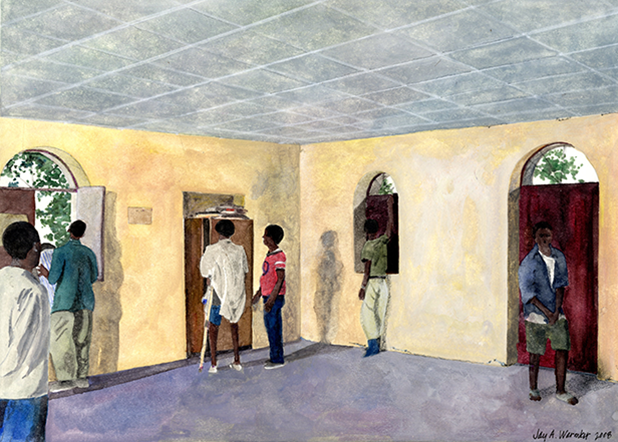 Exterior View (2009), 15” x 11” Watercolor, Jay A. Waronker
Exterior View (2009), 15” x 11” Watercolor, Jay A. Waronker
ethiopia
Former Synagogue at Ambober |
|

Interior View (2009), 15” x 11” Watercolor, Jay A. Waronker
|
Among the many places in Ethiopia that Beta Israel once lived is the village of Ambober. Ambober is located near the town of Gondar, the largest town in the region, and it is located in the rugged yet naturally beautiful Semien Gondar Zone of the Amhara Region. Today no Jews remain in Ambober, yet a building constructed as a synagogue still stands. It is can be found down a winding dirt road from the main paved thoroughfare that leads eventually to an parcel of land set on a grassy hill site and surrounded by small-scaled structures, mature trees, a quiet local community, and beautiful views out to the countryside. A low wall surrounds the synagogue property, and it includes a metal gate. Keys to the building remain in the hands of a stern older local non-Jewish gentleman who seems to enjoy the privilege and power of his gatekeeper position.
The synagogue building, constructed later than all others once used as Jewish houses of prayer by the Beta Israel in the immediate area, is a solidly-constructed structure built of dressed local stone set with ample mortar and a wood-framed roof framing system covered in galvanized corrugated metal sheets with deep overhangs. The soffits are closed, and along the fascia boards are galvanized metal gutters with leaders. At the peak of the hipped roof is a metal Star of David.
The building’s thick stone walls are punctured by small window with metal shutters painted a deep red. There is also a pair of narrow entry doors also made of metal and painted the same color. Above each window and the set of doors is a transom window detailed with a Star of David made of metal rods.
The synagogue’s interior, made up of a single nearly-square space, contains small window with metal shutters along the four walls, and a pair of narrow metal wooden doors. The windows and doors each have a transom that features a Star of David made of metal rods. The smooth walls are plaster and painted a pale yellow, the floor unpainted concrete, and the ceiling is flat and made up of painted-white panels butted up to one another and covered with batten strips. For some years this space has not been used, and at the time of this painting it was totally empty of furniture and fittings. There was also no electricity in the space, so the only source of light was natural from the opened doors and windows.
The synagogue’s interior, made up of a single nearly-square space, contains small window with metal shutters along the four walls, and a pair of narrow metal wooden doors. The windows and doors each have a transom that features a Star of David made of metal rods. The smooth walls are plaster and painted a pale yellow, the floor unpainted concrete, and the ceiling is flat and made up of painted-white panels butted up to one another and covered with batten strips. For some years this space has not been used, and at the time of this painting it was totally empty of furniture and fittings. There was also no electricity in the space, so the only source of light was natural from the opened doors and windows.
The Beta Israel, previously known as the Falasha (meaning derogatorily “foreigners” or “exiles”), are a well-known community of Jews that once lived in north and northwestern Ethiopia in hundreds of small towns and villages spread over a wide and remote territory. Claimed by some to have an ancient Jewish origin that has never been altogether authenticated despite rounds of DNA testing, for centuries the Beta Israel lived among populations that were predominantly Muslim and Christian. As a diminutive majority without contact with other Jewish communities anywhere in the world, for years they nevertheless maintained an identity that seemed to draw from traditional Jewish religious customs and long-established lifecycle practices. This included influences on their language, diet, and calendar.
Beginning in the late 1970s and continuing to the current day, thousands of Beta Israel Jews were evacuated either through Sudan or directly from Ethiopia to Israel via the careful planning and support of the Israeli and American governments. The Jews left Ethiopia due to the less-than-ideal conditions of a war-torn, communist-led, or economically depressed country, which included the government denying them the right to practice their religious freely and to live safe and secure lives. Israel embraced the immigration of Jews, although the settlement of the Beta Israel to the Jewish homeland did not always go smoothly and without question or even protest. Whereas the majority of the Beta Israel are now citizens of Israel and have contributed tremendously to the country, a few thousand remain in Ethiopia. These are ones who either chose not to earlier emigrate or who now claim to be Jewish or have come to embrace Judaism. They too are awaiting relocation to the Jewish State once complicated arrangements can be realized.
